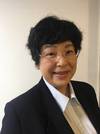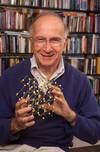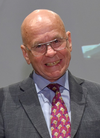

With the August Wilhelm von Hofmann lecture, the GDCh honors foreign chemists for their outstanding and up-to-date scientific work. The August Wilhelm von Hofmann Lecture was the GDCh's first named lecture. It is therefore also the only on-name lecture that is carried out without cooperation with a fellow society and served as a template for the later bilateral on-name lectures.
The lecture was held for the first time in 1978. The invited chemist was Jean-Marie Lehn from Strasbourg/France, who is one of the pioneers in the field of supramolecular chemistry. Since then, chemists from all over the world have been invited to Germany at regular intervals.

Professor Kazunari Domen of the University of Tokyo was awarded the August Wilhelm von Hofmann Lecture for his groundbreaking contributions to photocatalytic water splitting and solar-powered hydrogen production. He developed photocatalytic systems with near-perfect efficiency and successfully scaled them up to a globally unique pilot plant.
His work with aluminum-doped SrTiO₃ and innovative core-shell catalysts sets new standards for solar-to-hydrogen conversion. Professor Domen is a leading figure in the field of sustainable hydrogen production. With this award, the German Chemical Society (GDCh) recognizes his exceptional scientific influence and ongoing innovations.

Professor Kyoko Nozaki is an organic chemist at the University of Tokyo, Japan. Her research focuses on homogeneous catalysis in organic and polymer synthesis. Sustainability is a top priority for her. Her presentation at the GDCh Science Forum Chemistry 2019 was titled "Homogenous Catalysis for Today and Tomorrow."

Professor Roald Hoffmann received the 1981 Nobel Prize in Chemistry together with the Japanese Kenichi Fukui for research into the course of chemical reactions. In 1965, together with Robert B. Woodward, he developed the Woodward-Hoffmann rules, which are now part of the basic knowledge of organic chemistry.
Roald Hoffmann has been an honorary member of the GDCh since 1999 and was the first to awardee the Primo Levi Prize in 2017.

Professor Barry Sharpless works in the field of click chemistry, which coined the term very much. Sharpless works at the Scripps Research Institute (TSRI) in La Jolla / California.
In 2001 he was awarded the Nobel Prize in Chemistry together with William S. Knowles and Ryoji Noyori. He was honored for his important work in the field of stereoselective oxidation reactions. The name Sharpless is familiar to every chemistry student today, as many well-known reactions are named after it, such as the Sharpless epoxidation.

Professor Linda Nazar from the University of Waterloo / Canada deals with the development of lithium-ion batteries, such as lithium-sulfur accumulators. In doing so, she makes use of nanotechnology. Her lecture title at the GDCh Science Forum 2013 was "Overcoming the Challenges in High Energy Density Storage with Nanotechnology".
| 2011 | Emily Carter, Princeton / USA |
| 2009 | Daniel G. Nocera, Cambridge / USA |
| 2007 | George M. Whitesides, Cambridge / USA |
| 2003 | Jan-Erling Bäckvall, Stockholm / Sweden |
| 1999 | Jean-Marie Basset, Lyon / France |
| 1997 | Jon Clardy, Ithaca / USA |
| 1995 | Alan Roy Fersht, Cambridge / England |
| 1994 | François Diederich, Zurich / Switzerland |
| 1993 | Richard Alen Lerner, La Joila / USA |
| 1992 | Richard R. Ernst, Zurich / Switzerland |
| 1991 | Felix Franks, Cambridge / England |
| 1990 | Pierre de Gennes, Paris / France |
| 1989 | Hans Wynberg, Groningen / Netherlands |
| 1988 | Sir Jack Lewis, Cambridge / England |
| 1987 | Bogdan Baranowski, Warsaw / Poland |
| 1986 | Duilio Arigoni, Zurich / Switzerland |
| 1985 | Charles W. Rees, London / England |
| 1984 | Charles Weissmann, Zurich / Switzerland |
| 1983 | Norman Neill Greenwood, Leeds / England |
| 1982 | Wolfgang Oppolzer, Geneva / Switzerland |
| 1981 | Carl J. Ballhausen, Copenhagen / Denmark |
| 1980 | John Shipley Rowlinson, Oxford / England |
| 1979 | Allan Rushton Battersby, Cambridge / England |
| 1978 | Jean-Marie Lehn, Strasbourg / France |
Dr. Tom Kinzel, GDCh Executive Director (lead)
Prof. Dr. Stefanie Dehnen, Karlsruhe Institute of Technology, GDCh President 2024 & 2025
David Jurado M.Sc., JCF Freiburg
Prof. Dr. Ulrike Kramm, Technical University of Darmstadt
Prof. Dr. Peter H. Seeberger, Max Planck Institute of Colloids and Interfaces
Prof. Dr. Jennifer Strunk, Technical University of Munich
This page has been machine translated. If you have any feedback or comments please feel free to contact us. 
last modified: 14.10.2025 13:59 H from Translator